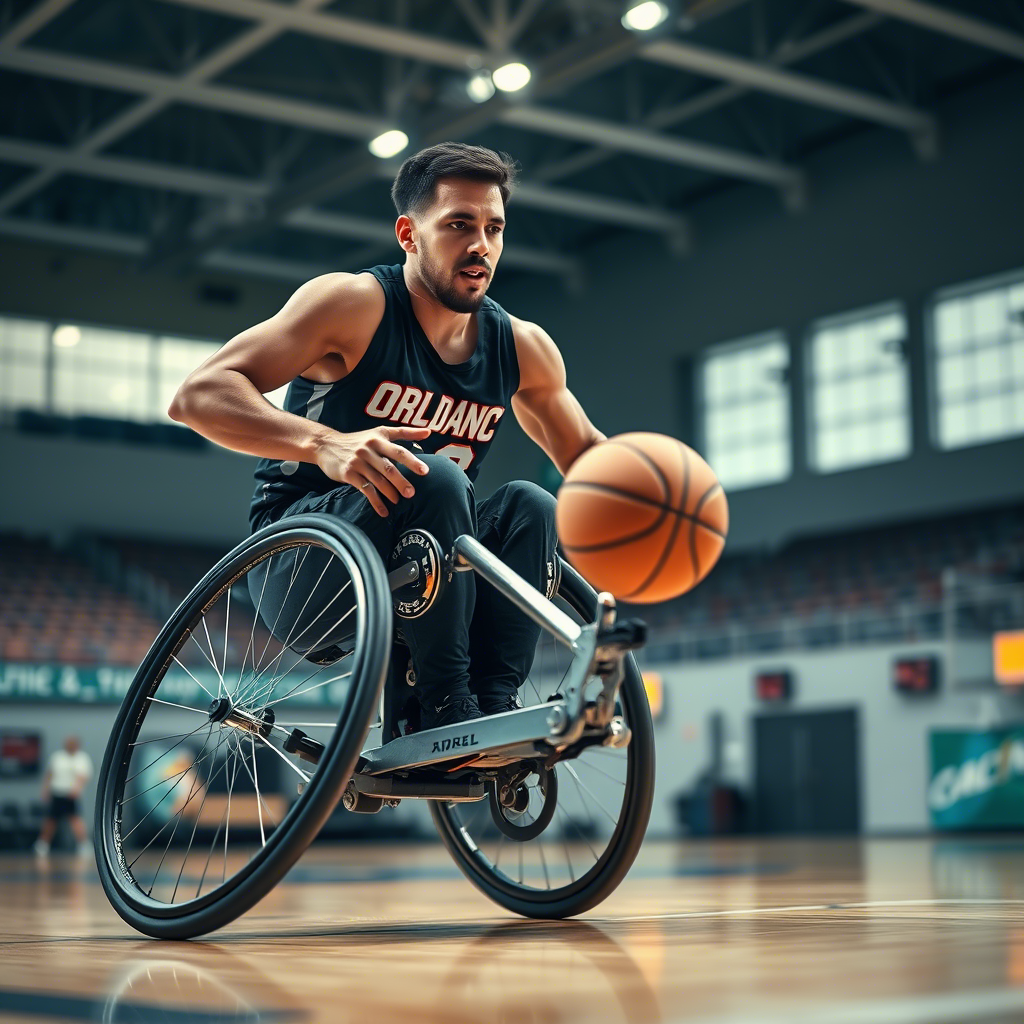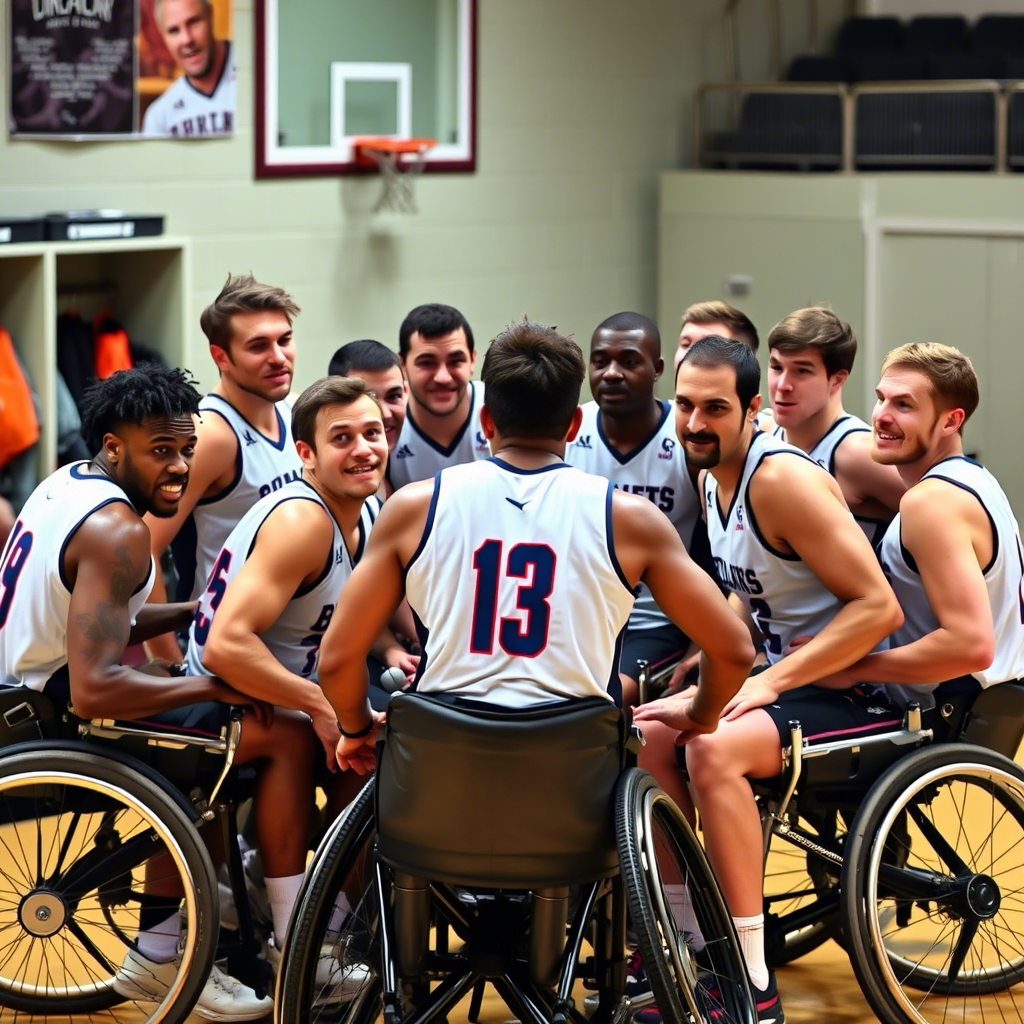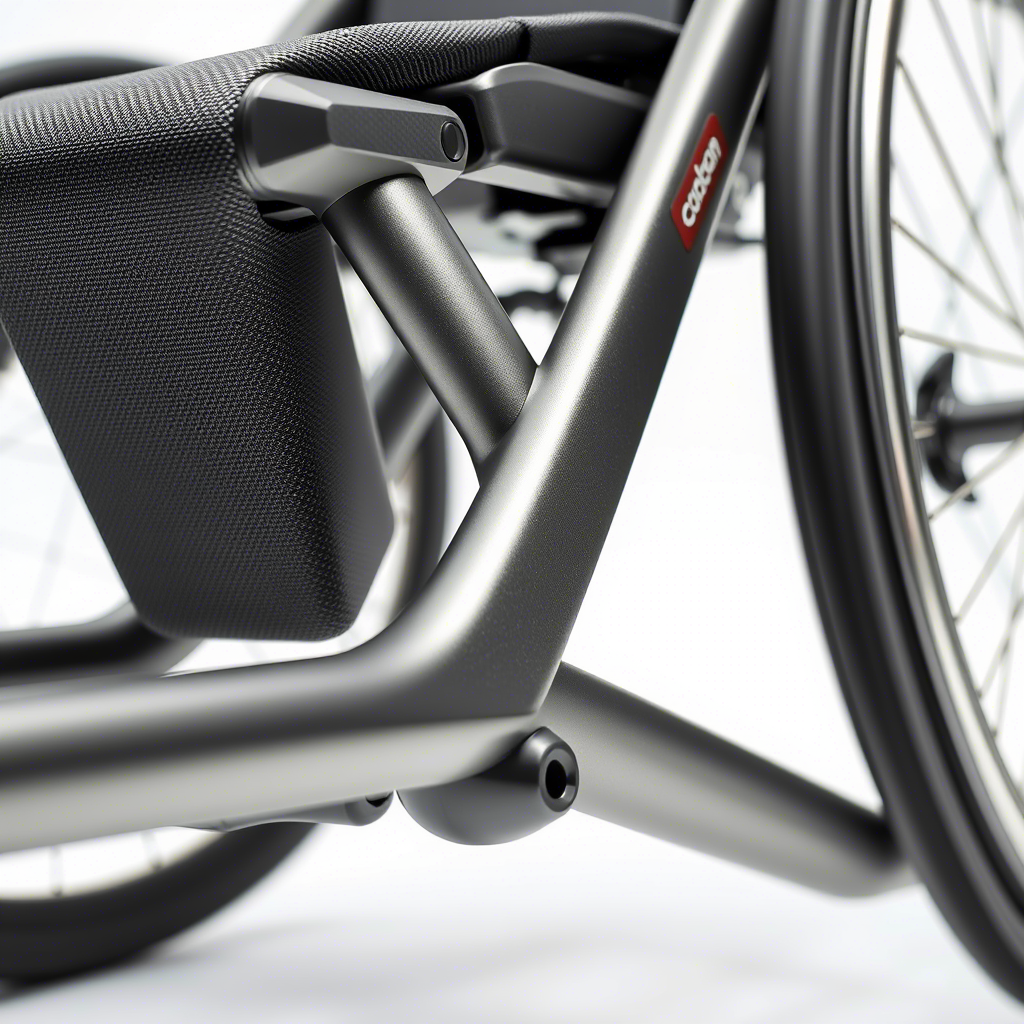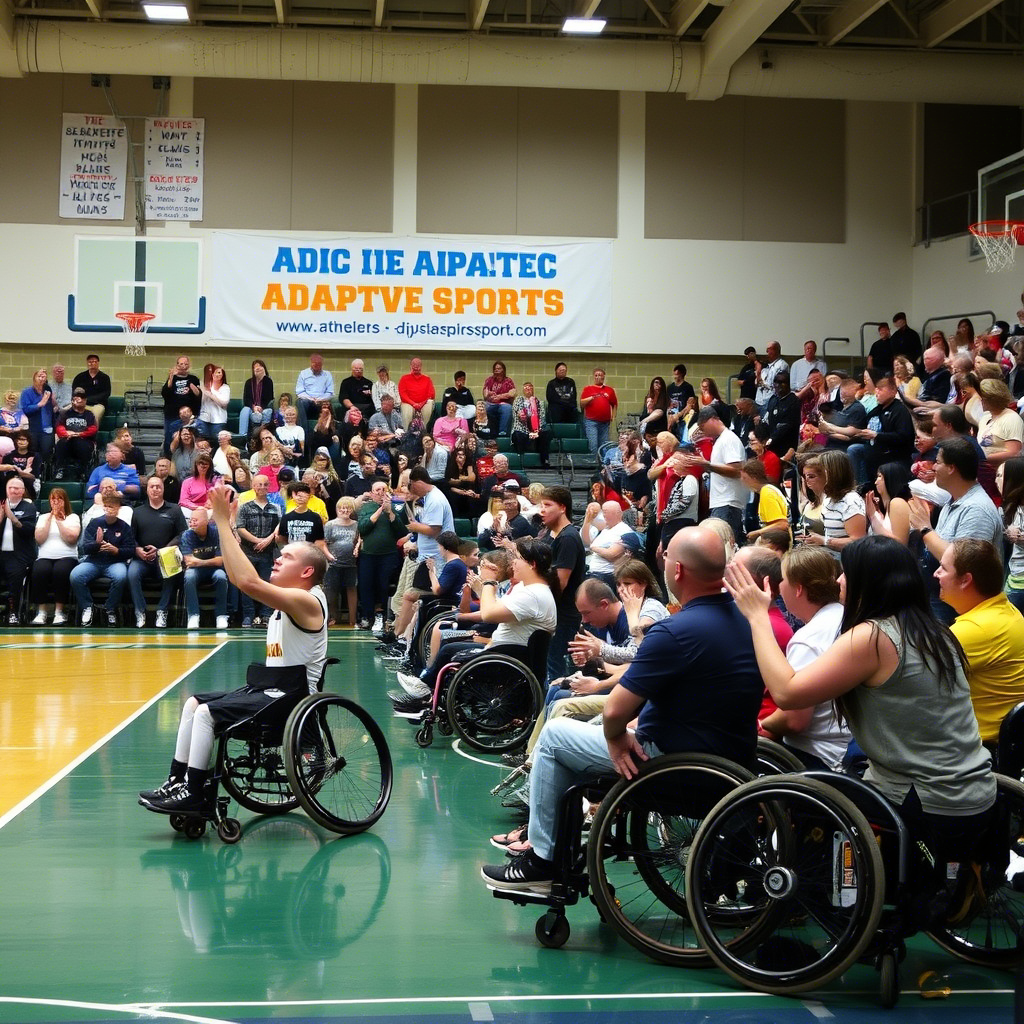Introduction
Have you ever felt like life was throwing you challenges that seemed insurmountable? Imagine having to rebuild your life while facing physical obstacles that most of us can’t even fathom. For many athletes in the world of wheelchair basketball, this isn’t just a hypothetical scenario—it’s their everyday reality. Today, we’re diving deep into the incredible universe of the Wheelchair Basketball Paralympics. This isn’t just a sport; it’s a powerful testament to the human spirit, resilience, and the transformative power of teamwork. Whether you’re an avid sports fan or someone searching for inspiration, the stories, strategies, and sheer determination on display in this arena are sure to light a fire within you.

In this comprehensive exploration, we’ll trace the roots of wheelchair basketball, meet the athletes who redefine athleticism every time they hit the court, and uncover the cutting-edge technology that is revolutionizing the game. Along the way, we’ll also provide practical insights on how you, as a member of the USA community, can support and even get involved with this uplifting movement. So, fasten your seatbelt and get ready for a journey where every dribble, pass, and basket is a victory for perseverance and human potential.
Related post :-[NBA Playoffs 2025: 5 Bold Final Four Predictions That Will Leave You Speechless]
The History and Evolution of Wheelchair Basketball
Humble Beginnings: A Sport Born from Adversity
Wheelchair basketball has its origins in the aftermath of World War II, when rehabilitation programs for injured veterans began incorporating sports as a means to rebuild both body and spirit. What started as a casual activity among veterans quickly evolved into a structured sport. In the 1940s and 1950s, pioneering individuals discovered that playing basketball from a wheelchair was not only therapeutic but also a way to foster camaraderie and community among those facing similar challenges.
During these early years, the game was characterized by improvised equipment and a spirit of innovation. Athletes would modify standard wheelchairs to make them more agile and suited for quick turns, much like modern sports engineers tweak high-performance cars for maximum efficiency. This early ingenuity laid the groundwork for what would eventually become a highly competitive international sport.
Milestones and Key Developments
Over the decades, wheelchair basketball has undergone tremendous evolution. The establishment of the National Wheelchair Basketball Association (NWBA) in the United States, and similar organizations around the globe, helped to standardize the rules and elevate the sport to new heights. The inclusion of wheelchair basketball in the Paralympic Games was a monumental milestone, marking its official recognition on the world stage.
- Technological Advancements: One of the most significant leaps in the sport’s evolution has been the advancement in wheelchair design. Modern sports wheelchairs are crafted from lightweight materials like aluminum and carbon fiber, allowing athletes to maneuver with incredible speed and precision. This technological innovation has turned the game into a fast-paced spectacle where strategy and physical prowess merge seamlessly.
- Increased Participation: Today, the sport boasts a 40% increase in participation over the past decade alone, a reflection of growing societal recognition and the increasing support for adaptive sports initiatives. These numbers are more than just statistics—they symbolize a shifting cultural landscape where disability is no longer seen as a limitation but as a different kind of strength.
- Global Recognition: With tournaments now held in nearly every continent, wheelchair basketball has become a truly international sport. The Paralympics serve as a grand stage where athletes from diverse backgrounds come together, united by a shared passion for the game and the belief in second chances.
An Analogy: The Phoenix Rising
Consider the legendary phoenix—a mythical bird that burns to ashes only to rise again, more vibrant and resilient than before. Wheelchair basketball embodies this very spirit. Each game is a rebirth of possibility; every match is an opportunity to defy expectations and rise above limitations. For athletes and fans alike, the sport is a powerful reminder that setbacks are merely the beginning of a new, more magnificent chapter.
Inspirational Stories: Meet the Trailblazers
Personal Triumphs on and off the Court
Behind every pass, shot, and victory in wheelchair basketball, there is a deeply personal story of struggle, determination, and ultimate triumph. These stories are not only inspiring but serve as real-life examples of how adversity can be transformed into strength.

The Journey of Michael “Mick” Thompson
One of the most compelling stories in recent years is that of Michael “Mick” Thompson, a former collegiate athlete who faced life-changing injuries in a car accident. With doctors predicting a future of limited mobility, Mick could have easily succumbed to despair. Instead, he found solace in the world of adaptive sports. Starting with local community leagues, his natural talent and unyielding determination soon propelled him onto the national stage. Today, Mick is a revered figure in the wheelchair basketball community, known not just for his on-court skills but also for his unwavering optimism. His story teaches us that while the road to recovery may be steep, it is also paved with opportunities to redefine what it means to be strong.
Sarah’s Story: A Beacon of Hope
Sarah, another inspirational athlete, discovered wheelchair basketball during her rehabilitation after a spinal injury. Initially hesitant, she quickly found that the sport offered not just physical benefits but also a renewed sense of independence and community. Through countless hours of training and the support of her teammates, Sarah transformed her life. Now, as an ambassador for adaptive sports in her hometown, she actively works to inspire young girls and boys with disabilities to pursue their athletic dreams. Her journey is a living testament to the idea that passion and perseverance can break down even the most daunting barriers.
The Impact of Role Models
Role models in wheelchair basketball are more than just exceptional athletes—they are beacons of change who challenge societal perceptions about disability. They prove that with dedication and support, anyone can achieve greatness. These trailblazers often go on to mentor younger athletes, share their experiences in motivational talks, and advocate for increased accessibility and support for adaptive sports programs nationwide.
A study by the International Paralympic Committee highlights that exposure to these role models has had a profound impact on public perception. Over 70% of young Americans reported feeling inspired to participate in sports after watching Paralympic events, a statistic that underscores the transformative power of these athletes’ stories.
The Role of Technology: Revolutionizing the Game
The Evolution of the Sports Wheelchair
Modern technology has played a pivotal role in transforming wheelchair basketball into the dynamic sport it is today. Gone are the days when athletes had to adapt to heavy, unwieldy wheelchairs. Today’s sports wheelchairs are marvels of engineering—designed for agility, speed, and comfort.
- Materials Matter: Advances in materials science have introduced ultra-lightweight metals and composites that allow for rapid movement and enhanced durability. This means that athletes can move faster and with greater precision, turning every game into a display of high-octane athleticism.
- Ergonomic Design: The design of these wheelchairs is the result of careful consideration of biomechanics. Engineers work closely with athletes to ensure that the chairs not only enhance performance but also minimize the risk of injury. The result is equipment that feels like an extension of the body—allowing for seamless integration of movement and strategy.
- Customization: Much like a tailor-made suit, modern wheelchairs are highly customizable. Each athlete’s chair can be adjusted to fit their unique body mechanics and playing style. This personalized approach ensures that every player can perform at their best, regardless of their physical condition.
Training with Technology
In addition to equipment, technology has also revolutionized the training methods used by wheelchair basketball athletes. High-tech training facilities now incorporate video analysis, virtual reality, and biomechanical sensors to help athletes refine their techniques and strategies.
- Video Analysis: Coaches use high-definition video recordings to analyze each player’s movements. This allows for detailed feedback on technique, positioning, and overall game strategy. Just as a musician listens to a recording of their performance to identify areas for improvement, athletes use video analysis to fine-tune every aspect of their game.
- Virtual Reality (VR): Some teams have begun incorporating VR into their training regimens. This cutting-edge technology simulates real-game scenarios, enabling players to practice decision-making under pressure in a controlled environment. It’s akin to pilots using flight simulators—allowing athletes to gain experience and build confidence before stepping onto the court.
- Biomechanical Sensors: These small devices can be attached to the wheelchair or the athlete’s body to track movement patterns, speed, and force. The data collected helps in creating personalized training programs that focus on both strengths and areas for improvement. With such detailed insights, athletes can push the boundaries of what they thought was physically possible.
An Analogy: Upgrading Your Smartphone
Think of the evolution of wheelchair basketball technology like the transformation of smartphones over the last decade. Early models were bulky, had limited functionality, and often fell short of users’ expectations. Today’s smartphones, however, are sleek, incredibly powerful, and designed to meet a vast array of needs. In the same way, the advances in sports wheelchairs and training technologies have taken wheelchair basketball from a humble recreational activity to a high-performance sport where every second counts and every move is calculated for maximum impact.
Game Strategy and On-Court Dynamics
The Art and Science of Gameplay
Wheelchair basketball is as much a mental game as it is a physical one. Every match is a strategic battle, where players must think several moves ahead while executing split-second decisions on the court.

Coordinated Teamwork: The Orchestra Analogy
Imagine an orchestra performing a complex symphony. Each musician plays a distinct role, yet the magic happens when they all synchronize perfectly. In wheelchair basketball, this coordination is paramount. The players must communicate constantly—whether through subtle signals, eye contact, or a well-timed call on the court—to ensure that everyone is in sync. This harmony of movements, passes, and strategies creates a dynamic and fluid game that is both unpredictable and exhilarating.
Tactical Breakdowns: Offense and Defense
Offense: Crafting the Perfect Play
On the offensive side, strategy revolves around quick passes, rapid wheelchair maneuvers, and finding the optimal moment to shoot. Coaches emphasize the importance of positioning and timing. Consider the following tactics:
- Pick-and-Roll: Similar to traditional basketball, the pick-and-roll is a staple in wheelchair basketball. One player sets a screen (or pick) for a teammate, who then uses the distraction to break free for a shot. This move requires precision and trust between teammates.
- Fast Breaks: Speed is of the essence. Teams often execute fast breaks—where players transition quickly from defense to offense—to catch opponents off guard. The key is to maintain a balance between aggression and control.
- Zone Offense: When facing a tight defense, teams might switch to a zone offense, where players occupy specific areas on the court. This strategy helps in creating gaps in the defense, opening up opportunities for a clean shot.
Defense: Holding the Line
Defensive strategies in wheelchair basketball are designed to neutralize the opponent’s strengths while capitalizing on any lapses in their coordination.
- Man-to-Man Defense: Each defender is assigned a specific opponent to track and block, requiring constant vigilance and quick adjustments. This approach is particularly effective when paired with rigorous communication and a deep understanding of one another’s tendencies.
- Zone Defense: In situations where the opposing team is executing well-rehearsed plays, a zone defense can be highly effective. By assigning players to cover specific areas rather than individuals, teams can better anticipate and counter offensive strategies.
- Transition Defense: After a turnover or missed shot, transitioning from offense to defense swiftly is crucial. Players must quickly reorient themselves to protect the basket, often relying on pre-planned formations and signals from the coach.
Training Regimens: Building Strength and Strategy
Behind every spectacular play lies countless hours of rigorous training. Athletes invest not just in physical conditioning but also in mental preparation. Here are a few insights into the training regimens that make wheelchair basketball players some of the best in adaptive sports:
- Strength and Conditioning: Just as a marathon runner builds endurance, wheelchair basketball players engage in strength training to enhance their upper body and core muscles. Weightlifting, resistance training, and cardiovascular exercises form the backbone of their physical preparation.
- Skill Drills: Repetitive drills are essential for honing ball-handling skills, passing accuracy, and shooting precision. These drills are designed to mimic game situations, allowing players to develop muscle memory and quick reflexes.
- Mental Conditioning: The psychological aspect of sports is just as important as the physical. Many teams incorporate mindfulness, visualization techniques, and tactical discussions into their training sessions. This mental fortitude helps players remain calm under pressure and make strategic decisions in the heat of the moment.
Community Impact and Advocacy
A Catalyst for Change in Society
Wheelchair basketball is more than just a sport—it’s a movement that challenges societal perceptions about disability and ignites conversations about inclusion and equality. In the USA, where the conversation about accessibility and representation is growing louder, the impact of adaptive sports like wheelchair basketball cannot be overstated.

Building Community Through Sport
For many, the sport serves as a bridge connecting diverse communities. Local tournaments, clinics, and exhibitions are not only competitions—they are community events where families, friends, and supporters come together. These gatherings foster a sense of belonging, where differences are celebrated and every victory is shared collectively.
- Local Heroes: In communities across the USA, local athletes have become heroes who inspire others to push past their limitations. Whether it’s a high school team championing the sport or a local league organizing regular meet-ups, these events are a testament to the unifying power of sports.
- Educational Outreach: Many organizations are now partnering with schools and community centers to introduce adaptive sports programs. These initiatives help break down the stigma associated with disability, encouraging young people to see ability rather than limitation. In doing so, they lay the groundwork for a more inclusive future.
Advocacy and Social Change
Wheelchair basketball also plays a crucial role in advocacy. The athletes and organizations behind the sport are often at the forefront of campaigns aimed at increasing funding for adaptive sports, improving accessibility in public spaces, and influencing public policy. Their voices add a powerful narrative to the national dialogue on equality and inclusion.
- Legislative Impact: Through grassroots campaigns and advocacy initiatives, many adaptive sports organizations have successfully lobbied for increased government support and funding. These efforts have led to improved facilities, better training programs, and more robust media coverage.
- Inspiring Future Generations: The stories of Paralympic athletes are frequently featured in educational curricula and motivational programs across the country. By showcasing the achievements of wheelchair basketball players, educators inspire the next generation to dream big and overcome obstacles.
A Personal Note on Community
I still remember the first time I attended a local wheelchair basketball game in my hometown. The energy in the arena was palpable, and the connection among fans was unlike anything I’d experienced before. It wasn’t just about cheering for a win; it was about celebrating the human spirit in its purest form. That day, I witnessed firsthand how sports can transform lives and create communities that are supportive, resilient, and fiercely inclusive.
How to Get Involved: Making a Difference in Adaptive Sports
Supporting Local Teams and Organizations
For many Americans, the desire to support adaptive sports stems from a deep appreciation for the courage and dedication of the athletes. Here are several actionable steps you can take to get involved:

Attend Local Games
- Engage with Your Community: Many cities and towns host local wheelchair basketball games, tournaments, and exhibitions. Attending these events is an excellent way to show your support, meet like-minded individuals, and gain a deeper appreciation for the sport.
- Spread the Word: Word-of-mouth and social media play a huge role in raising awareness. By sharing your experiences at local games, you help amplify the voices of these incredible athletes.
Volunteer Your Time
- Community Outreach: Look for local organizations or teams that are actively involved in promoting adaptive sports. Volunteering can range from assisting at events, mentoring young athletes, or even helping with administrative tasks. Your time and enthusiasm can make a real difference.
- Advocacy Work: Many organizations need volunteers to help with advocacy campaigns aimed at improving facilities, securing funding, and promoting inclusive policies. Even a few hours a week can contribute to long-lasting change.
How to Champion the Movement Online
Social Media Advocacy
In today’s digital age, social media is a powerful tool for advocacy and community building. Here are some ways to leverage online platforms:
- Follow and Share: Start by following official Paralympic accounts, wheelchair basketball teams, and adaptive sports advocates. Share their stories, successes, and upcoming event details on your own social media platforms.
- Engage in Conversations: Join online communities, comment on posts, and participate in discussions that promote inclusion and adaptive sports. Your voice matters, and engaging in these platforms can help break down stereotypes and educate others.
- Create Content: If you’re a blogger, photographer, or videographer, consider creating content that highlights the spirit of wheelchair basketball. Whether it’s a blog post, a series of photos, or a short video, your creative contributions can reach a wide audience and inspire change.
Fundraising and Sponsorship
Supporting adaptive sports financially is another impactful way to get involved:
- Donate: Many nonprofit organizations rely on donations to fund training programs, equipment upgrades, and community outreach initiatives. Even small contributions can add up to significant improvements in the lives of athletes.
- Sponsorship: If you own a business or are in a position to influence corporate decisions, consider sponsoring local teams or events. Sponsorship not only provides financial support but also increases visibility for the sport.
Educational Initiatives
Educating yourself and others about the importance of adaptive sports is essential for creating a more inclusive society.
- Workshops and Seminars: Attend or organize educational workshops that focus on the benefits of adaptive sports. These sessions can cover topics ranging from the history of wheelchair basketball to modern training techniques.
- School Programs: Advocate for the inclusion of adaptive sports in school curricula and extracurricular activities. By exposing young people to these inspiring stories early on, we can foster a more empathetic and inclusive generation.
The Future of Wheelchair Basketball: Trends and Predictions
Continued Growth and Global Impact
The future of wheelchair basketball looks brighter than ever. As technology continues to advance and societal attitudes become more inclusive, the sport is poised for even greater global recognition. Here are some trends and predictions shaping the future:
Increasing Media Coverage
In recent years, media coverage of the Paralympics and adaptive sports has increased exponentially. Major networks and streaming platforms are dedicating more airtime to these events, which in turn helps to normalize and celebrate the achievements of these athletes. With more exposure, we can expect to see an even greater influx of fans, sponsors, and aspiring athletes.
Technological Innovations
The rapid pace of technological advancements shows no signs of slowing down. Future innovations in wheelchair design, training equipment, and performance analytics will likely further enhance the competitiveness of the sport. Imagine a future where artificial intelligence assists coaches in devising real-time game strategies or where virtual reality training becomes the norm for preparing athletes for high-pressure scenarios.
Expanding Access and Inclusivity
As adaptive sports continue to gain popularity, initiatives aimed at increasing access for people with disabilities will flourish. Government agencies, nonprofits, and private enterprises are increasingly investing in programs that promote inclusion through sports. This trend is particularly strong in the USA, where the push for equality and accessibility is reshaping public policy and community infrastructure.
Emerging Talent and Grassroots Movements
One of the most exciting prospects for the future is the emergence of new talent. Grassroots movements across the country are introducing young athletes to wheelchair basketball, creating a robust pipeline of future stars. These programs are not only developing athletic skills but also instilling values of teamwork, perseverance, and resilience. As more communities embrace adaptive sports, the level of competition and the quality of play will continue to soar.
A Vision for the Next Decade
Looking ahead, the vision for wheelchair basketball is one of integration, innovation, and inspiration. Here are a few predictions for the next decade:
- Integration with Mainstream Sports: As adaptive sports gain more traction, we may see greater integration with mainstream sporting events. Collaborative events, exhibition matches, and mixed-ability competitions could become more common, further blurring the lines between traditional and adaptive sports.
- Enhanced Athlete Support: With increased funding and advocacy, athletes will have access to even better training facilities, equipment, and medical support. This will not only improve performance on the court but also enhance the overall well-being of the players.
- Global Unity Through Sport: The Paralympics and wheelchair basketball serve as powerful reminders that sports have the unique ability to unite people across cultural, geographical, and social boundaries. In the coming years, this unity is likely to become even more pronounced, fostering a sense of global community centered around resilience and mutual respect.
Real-Life Anecdotes: The Human Element Behind the Game
A Day in the Life of a Paralympian
To truly understand the impact of wheelchair basketball, one must look beyond the statistics and headlines to the everyday lives of the athletes. Consider the story of Jason—a young man from a small town in the Midwest whose life changed forever after a spinal injury. Before his accident, Jason was a star athlete in high school, known for his energy and competitive spirit. When he found himself confined to a wheelchair, he faced an emotional and physical battle unlike any other.
Instead of retreating into isolation, Jason discovered wheelchair basketball through a local adaptive sports program. His initial practice sessions were fraught with challenges—learning to maneuver a new set of wheels, building upper body strength, and adapting to a completely new style of play. But with every practice, every game, and every setback, Jason found a renewed sense of purpose. Today, he’s not only a competitive athlete but also a mentor to newcomers, encouraging them to see beyond their limitations and embrace the transformative power of sport.
The Ripple Effect: Inspiring Change Beyond the Court
There are countless stories like Jason’s that illustrate the far-reaching impact of wheelchair basketball. These athletes often become catalysts for change in their communities, inspiring others to overcome adversity and strive for excellence. Whether it’s a motivational speech at a local school, a community fundraiser, or simply being a role model in everyday life, the influence of these athletes extends far beyond the boundaries of the court.
One particularly moving story comes from a small town in California where a local wheelchair basketball team organized a community outreach event. Families, local businesses, and community leaders gathered to celebrate the achievements of the athletes, and the event sparked a broader conversation about accessibility and inclusion in public spaces. The positive impact of that day continues to be felt, as local policymakers have since introduced measures to improve accessibility in parks, community centers, and schools.
How to Support and Advocate for Wheelchair Basketball
Championing Inclusion in Your Community
In the USA, the call for greater inclusivity and accessibility is louder than ever. As a fan of wheelchair basketball, you have a unique opportunity to contribute to this movement on multiple levels.
Become an Active Supporter
- Attend Games and Tournaments: Nothing beats the thrill of live sports. Attend local wheelchair basketball games to cheer on your favorite athletes. Your presence not only boosts team morale but also raises awareness about the sport.
- Share Their Stories: Use your social media platforms, blogs, or local media outlets to share the inspirational stories of these athletes. By amplifying their voices, you help create a narrative that celebrates ability, determination, and inclusivity.
Get Involved Locally
- Volunteer: Reach out to local adaptive sports organizations and see how you can help. Whether it’s organizing events, mentoring young athletes, or assisting with administrative tasks, your involvement can make a significant difference.
- Fundraise: Organize community fundraisers or participate in charity events that support wheelchair basketball programs. Every dollar raised helps provide better training facilities, cutting-edge equipment, and expanded outreach initiatives.
- Advocate: Engage with local government and community boards to promote policies that improve accessibility and support adaptive sports. Your voice can help drive the changes needed to create a more inclusive society.
The Broader Impact of Your Support
When you support wheelchair basketball, you’re not just cheering for a game—you’re standing up for a movement that challenges stereotypes, promotes inclusivity, and inspires change. The ripple effects of your support can lead to improved infrastructure, increased funding for adaptive sports programs, and, ultimately, a society that values every individual’s unique contributions.
Embracing the Spirit of Resilience: Lessons from the Court
What Wheelchair Basketball Teaches Us About Life
At its core, wheelchair basketball is a masterclass in resilience, innovation, and the power of teamwork. Here are a few life lessons we can all learn from the sport:

- Resilience in the Face of Adversity: Every athlete on the court has faced a challenge—be it a physical limitation, societal prejudice, or personal hardship. Their ability to bounce back, adapt, and excel is a powerful reminder that setbacks are merely setups for comebacks.
- The Value of Teamwork: Success in wheelchair basketball doesn’t come from individual brilliance alone. It is a collaborative effort where trust, communication, and mutual support are paramount. In life, as in sports, working together can help us overcome even the toughest challenges.
- Innovation and Adaptability: The evolution of wheelchair basketball—from rudimentary equipment to state-of-the-art technology—illustrates the importance of innovation. Embracing change and constantly striving for improvement can open up new possibilities in every aspect of life.
- Inspiration Through Action: The athletes in this sport live proof that a challenging start does not define your journey. Their stories encourage us to pursue our dreams with passion, regardless of the obstacles we may encounter.
A Call to Embrace Your Own Journey
Whether you’re facing personal challenges, seeking new avenues for growth, or simply looking for inspiration, let the spirit of wheelchair basketball guide you. Every dribble, every pass, and every shot is a reminder that with perseverance and teamwork, you can overcome any obstacle and create your own path to success.
The Future is Now: How You Can Be a Part of the Movement
Taking the Next Step
The world of wheelchair basketball is vibrant, dynamic, and full of opportunities for growth and inclusion. As we look to the future, there are countless ways you can be part of this evolving narrative. Whether you’re a seasoned sports enthusiast or someone newly inspired by the stories of these remarkable athletes, your support is invaluable.
- Join Local Adaptive Sports Groups: Look for local clubs or recreational leagues that promote wheelchair basketball and other adaptive sports. Your participation can help foster community spirit and drive local change.
- Engage in Continuous Learning: Stay informed about the latest developments in adaptive sports technology, training methods, and advocacy efforts. The more you know, the better equipped you are to contribute to the movement.
- Network and Collaborate: Connect with like-minded individuals, attend conferences, and participate in online forums dedicated to adaptive sports. Collaboration is key to building a robust support system that transcends individual efforts.
Transforming Challenges into Opportunities
For many athletes, every game is a battle against both physical challenges and societal expectations. Yet, it is in these very challenges that opportunities are born. By embracing the ethos of wheelchair basketball—where every obstacle is met with ingenuity and every setback is a stepping stone to victory—you too can transform challenges in your own life into opportunities for growth.
Conclusion
Wheelchair basketball at the Paralympics is much more than a competitive sport—it is a vibrant tapestry of human spirit, determination, and community. From its humble beginnings as a rehabilitative activity for injured veterans to its current status as a globally recognized sport, every element of wheelchair basketball speaks to the power of resilience and the endless possibilities that lie within each of us.
As we celebrate the athletes who defy expectations and push the limits of what is possible, we are reminded that every challenge carries within it the seeds of transformation. Their journeys serve as a call to action: to embrace our own struggles, to support one another, and to build a community where every individual is valued for their unique abilities.
Today, I invite you to be a part of this inspiring movement. Whether it’s by attending a local game, volunteering your time, or simply sharing the stories of these remarkable athletes, your involvement can make a tangible difference. Let the triumphs on the wheelchair basketball court remind you that every setback is an opportunity to rise stronger. Embrace the challenge, support the movement, and together, let’s celebrate the indomitable spirit that unites us all.
